What looks like an iceberg in the middle of a lake or a half-melted marshmallow is actually is an experimental living structure inhabited by art students. Indianapolis Island is an art piece created by Andrea Zittel and inhabited this summer by art students Jessica Dunn and Michael Runge. It is one of the eight works of art in the Indianapolis Museum of Art’s 100 Acres art and nature park.
About 20 feet in diameter, Indianapolis Island is a tiny house made of fiberglass and foam that examines the daily needs of contemporary human beings. For the next four summers, the island will be occupied by one or two commissioned residents who are local art students. They will collaborate with Zittel by adapting and modifying the island’s structure according to their individual needs.
On their blog, Dunn and Runge discuss the details of living in an inhabitable art space. They have access to the museum’s Visitor’s Pavillion where there are restrooms, and they also have an emergency sawdust bucket for late-night bathroom needs. They are able to stay cool because of the good insulation of the island and the white color that reflects away the sun. The door and window provide air flow from the cool lake water. They cook with a solar oven, a small grill and use a cooler for their food.
Dunn and Runge will get a lesson in sustainable living during their stay from mid-June to mid-August on the island. Their plans are to grow their own food in floating pots, make their own furnishings, generate electricity with a bicycle and receive messages from others via floating capsules. The tiny floating island will also allow visitors. When the students raise a green flag on the island, guests may ring a bell on the shore to signal their desire for a tour. Visitors will then be picked up in a row boat and given a tour highlighting the efficient living space. When the island’s inhabitants are not giving tours they will create a message-writing centers for visitors to author their own anonymous messages, which they will release in floating containers which look like little floating islands of their own. The messages will then be posted on Dunn and Runge’s blog.
Photos courtesy of Jessica Dunn and Michael Runge
By Christina Nellemann for the [Tiny House Blog]


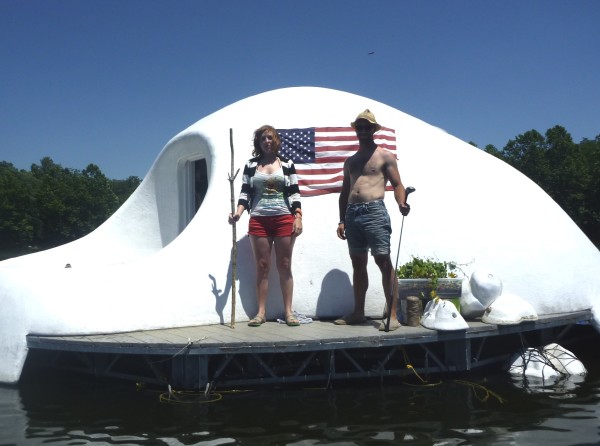
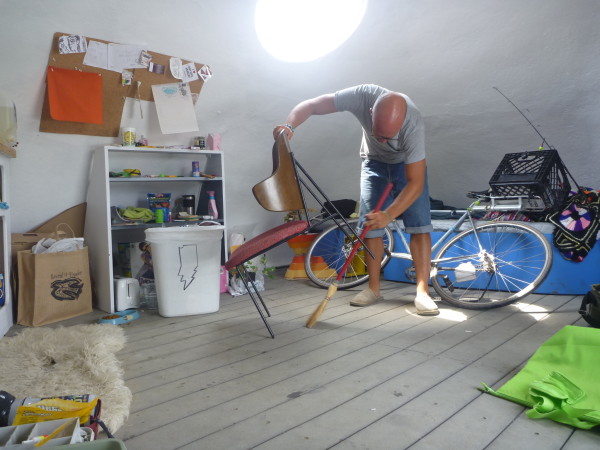

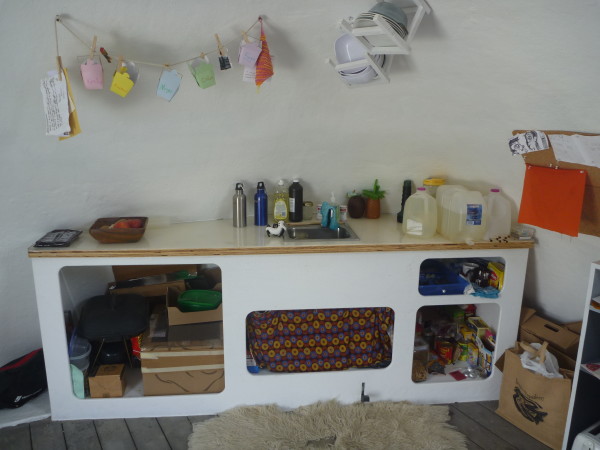
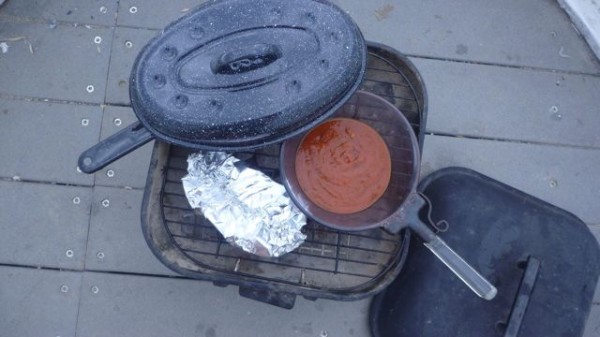
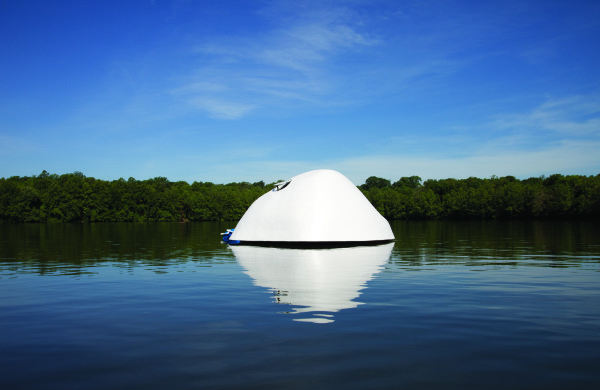
That’s unique, that’s for sure! The tiny island idea reminds me that on part of our farm property, where my grandparents’ old house is, there is a 2.4 acre pond with an 1,100 square foot island in the middle (I was curious about the measurements, so I loaded a satellite photo into Autocad to trace the outlines and measure them). I always thought it would be neat to have a little cabin or something on there, except it’s so small that it probably would be better to have the cabin at the edge of the pond, rather than having to row to shore every time you needed something.
Cool little structure!
I know this expariment is about figuring out what you really need. But as a piece of art, I would say that it is more asthetically pleasing from the outside.There is a lesson in there about clutter, and the beauty of integrated furnishings.
I’m curious about the bed. It looks like maybe the pieces separate and probably have interior storage. Anyone know the source?
The bed was designed and built by Jessica and Micheal. It did open up and the pieces could be reconfigured into a table and benches. The kitchen was functional with a pump to get fresh water for dish washing and hand washing. They exchanged hand made art and jewelry with visitors who often brought them food and batteries as well as art people wanted to share.
As an artist, I would not consider this art, but I guess anything can be called art today, unfortunately.
As a tiny abode, I find it interesting, though not really what I would consider to be livable without a bathroom/kitchen. It definitely has possibilities if they can get away from the “art” part.
Good points. I sort of tuned out the part where they called it a “work of art” and focused on the idea of living in a tiny structure in the middle of a lake – that part is interesting to me. It’s unique, but I would never dare call it a work of art. And I agree completely about it not being very livable. All it is right now is a shelter. I’d like to see something like this, on a little bigger scale, with some actual rooms, and some manner of plumbing/toilet, kitchen area, etc. Something worth living in.
I understand where you are coming from Deborah, however I think we need to be careful about how we project our own views upon others (stay open to everything). Watch how I can quote your opening phrase just exchanging one word(and root word) for another.
Now hear this being said by a (read it back in the same tone as you typed it) parent or friend who dose not understand what a tiny house is, or why you want to live without a two car garage and 6 bedrooms.
“As an HomeOwner, I would not consider this a home, but I guess anything can be called a home today, unfortunately….
sorry if I come of as condescending, just trying to remind everyone that we are in a “fringe movement” that other people do not understand…Being open to new ideas is the greatest thing you can do with your mind. Lets treat other peoples ideas with respect even if we don’t understand them.
That’s her opinion, she’s entitled to that. Some people will would take a crap on a platter and call it art. A person is entitled to disagree. The fact that she’s an artist of some sort gives her, perhaps, a little more license to do so. If an accomplished concert pianist tells you that he doesn’t consider you to be a musician because all you can play is Chopsticks and Mary Had a Little Lamb, that’s not only an opinion, but a qualified one at that.
In response to your analogy about a home – some people live in a car and call it home; most people wouldn’t consider that a home, and would, I think, be justified in saying so. If a homeowner (or “an HomeOwner” if you prefer for some strange reason) said that they don’t consider this to be a home, is that wrong? How about if they said that as a homeowner, they didn’t consider you a homeowner for owning and living in a structure similar to this?
To begin with, that would be their opinion. Beyond that, if you owned this (or something similar), would a reasonable person consider you to be a homeowner? No. Would you qualify as a homeowner for legal purposes, insurance purposes, tax purposes? No. Would this qualify as a home or a house by building and zoning standards? No. After all, isn’t part of what goes in to designing, building, and finding a place for a tiny house devoted to determining how, or where to put your house, to avoid, circumvent, or comply with building and zoning regulations, precisely because many or most of these structures don’t qualify as houses or homes?
Nice post Josh, thank you for the honest feedback. Certainly everyone has a right to his or her own opinion, I never wanted to diminish this in any way, nor was the goal of my comment to condescend upon the substance of Deborah’s opinion, but rather how that opinion was expressed (in this particular case). Josh I don’t know what your background is in tiny homes or if you have built or planing to in the future? Have you ever tried to share your dream with someone(friend, family, loan officer, contractor etc), and you get scoffed or subtle ridicule because your ideas and theirs don’t meet the same definition? What I was simply proposing was that we(people who are into tiny homes, and other unconventional small homes) adopt a stance that is more understanding of things(arts, design, architecture, technology) that don’t fit into our definition of what said “thing” should be….in short and extrapolation/adaptation of the Golden Rule…don’t hate/prejudge on my “X” which you don’t understand, and I will do the same to your “Y” which I don’t understand…You can still say; “I don’t understand “this” is not for me” without devaluing it and saying “I don’t understand “this” therefore “this” is not worthy of even being called/compared to a piece of…”
I like the art/sculptures and installation by Zittel, they may not be for everyone, just as Jackson Pollack is not “art” to many people, but he is still an artist despite what critics reproach.
http://www.zittel.org/
http://en.wikipedia.org/wiki/Andrea_Zittel
BTW kinda OT Deborah do you have any real art (perhaps some of you own) to show us???
A couple of shelves to put a single burner stove and some dishes on, a box to keep food in and a bit of prep space are all some people need for a kitchen, even for extended periods of time. The island has a perfectly functional kitchen space in the picture I see. Now a bathroom, that’s another story. Having to go all the way to some visitor centre just to pee is not my idea of having a bathroom! A fully enclosed, convenient space at least big enough for a sawdust toilet and some provisions for hand washing are the minimum I’d put up with at my shack.
I remember seeing this in a mag way back- a great looking little structure- and a brave idea!
Very cool Kent…
-Deek
-Relaxshacks.com
I happen to know that the artist who actually produced this piece (ie. used a design to create and install this piece as a real living space.) He holds more than one advanced degree in art and has been a respected working artist and fabricator for more than 20 years. He would beg to differ with any self-proclaimed artist blogging here as to whether or not this piece is either art or a living space.
How difficult it must be to create anything truly new and boundary-pushing with a closed mind.
When we use such broad definitions, the question isn’t, “what is art?” The question becomes, “what isn’t?” An art professor at my alma mater defined “drawing” as anything that involves line and movement. And he was serious. Since every action we make involves line and movement, my walk to the classroom is, by his definition, a drawing. One student stripped his clothes off, got on his bike, rolled over a line of styrofoam cups filled with water and received a passing grade for his successful mastery of “drawing.” If I told you that I spent the morning “drawing,” and you accept this sort of broad definition, you actually have no idea what I spent the morning doing. Eating pop tarts “involves line and movement.” So you have to ask for a clarification because words have no specific meaning. If you ask me “what kind of drawing did you do?” I’ll just give you a z-snap, and, as this gesture involves line and movement, I’ve answered your question by producing a “drawing.” Words without specific meaning have none.
Well said, Chris. I am not an artist. I am a licensed professional builder.
As a consumer of art and architecture, I call all kinds of things art. I was immediately drawn to this shelter because of a piece of cob and plaster I hand built. I was attending a Cob-Building Workshop and we were assigned the work of building a small cob shelter. We’ll I was a itinerant rock climbing bum and have spent time around beautiful rocks and even lived in caves. I Simply formed a Loaf an then inserted my thumbs and smoothed it. It was this shape exactly…and the crowd went wild. (gotta go kids here)
Hmm. It looks like an igloo without the benefit of a “self cleaning” (melting) inner surface or being 100% biodegradable. 😉 Also, while the entrance appears to be designed to keep out water, it would make it more difficult and time consuming to clean out unless one is sweeping things down through the floor, which is a poor environmental idea. Regarding color, white would look natural in the arctic, but here it simply shocks the eyes rather than blending in in an organic way that would make it aesthetically pleasing (I wonder what Thoreau would think?).
I agree about the toilet and convenience issues others have raised, and, given the building materials used, why *not* design a more efficient use of space to allow for living necessities and cooking facilities?
I think that the original “tiny home” very thoughtfully and brilliantly “examine[d] the daily needs of contemporary human beings” and came to some excellent design conclusions as evidenced by the amount of time in continuous YEAR-ROUND residence. And, BTW, how can one know that what they are doing can possibly be deemed “sustainable” if they are only living that way during the easy months of the year?
Those who have lived in very small environments (houseboats, yachts, small cottages, small mobile homes, space stations, and the like) already have an excellent grasp on the concept and would be excellent resources on the topic as their experiences are not theoretical but actual and practical. They are more interested in necessities arranged efficiently as opposed to cultural expectations and, like those living in undeveloped nations, are certainly not doing it just to be primarily experimental/artistic (which, by the way is a more western approach).